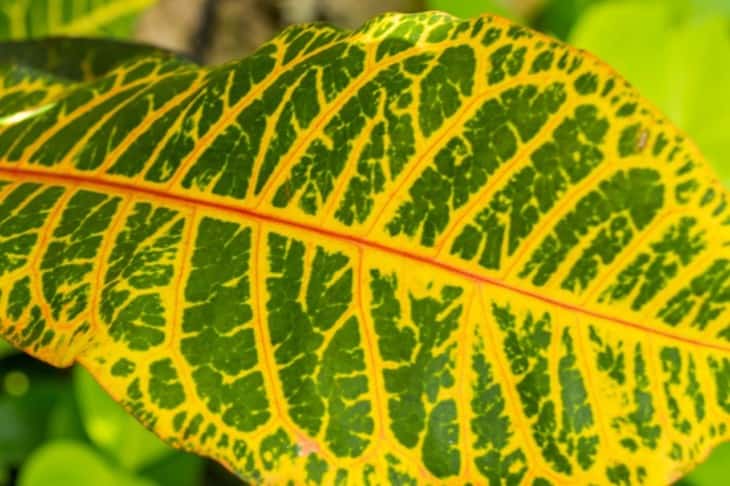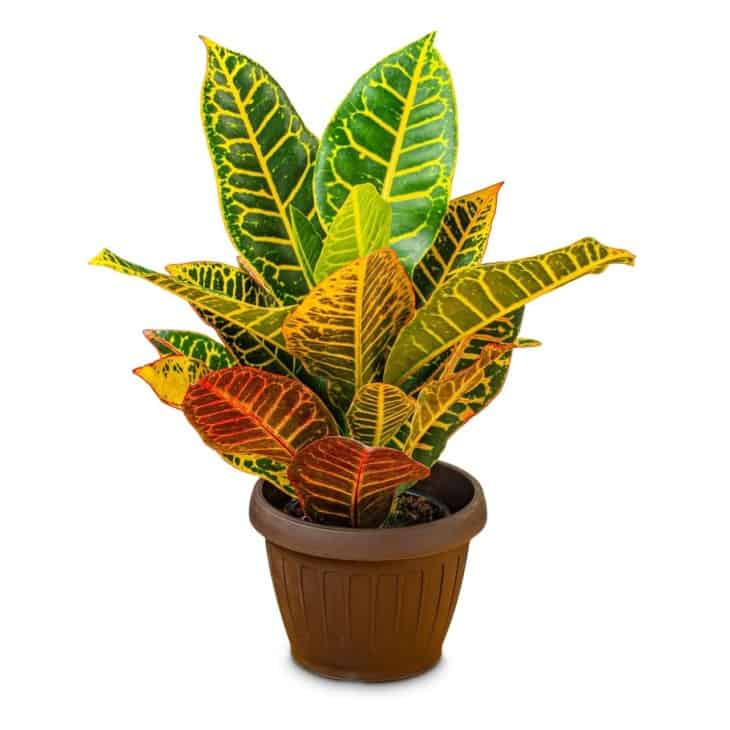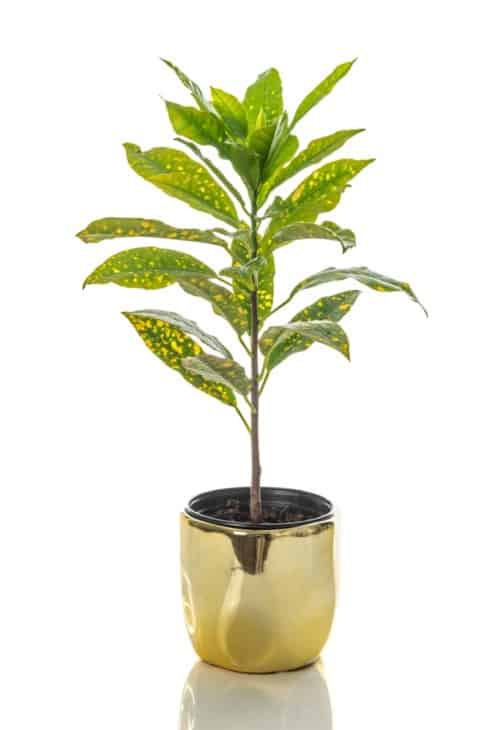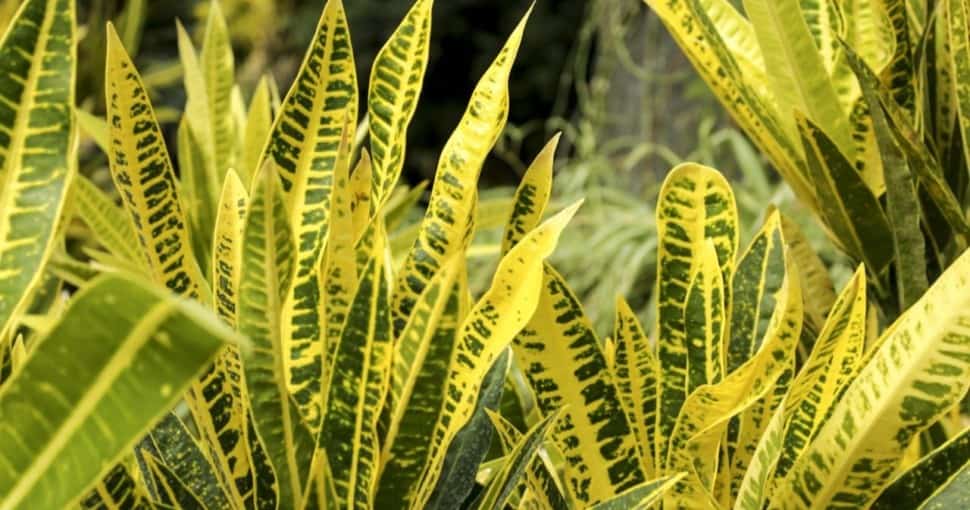Croton plants originate from India and Malaysia, where they grow wild. They are popular indoor plants due to their striking leaf colors and shapes. Codiaeum variegatum is a challenging plant to grow, but its luxurious appearance encourages people to attempt keeping them. Croton plants are sometimes described as art pieces in the plant world. Many plants have other uses, and this beautiful plant has been explored to see if it is beneficial in any way.
Contents
Croton plants have been used in traditional medicine in South America, Africa, and Asia for hundreds of years. Scientific research has shown that croton has substances that can reduce high cholesterol and blood sugar. It has anti-inflammatory and muscle relaxant properties, amongst other benefits.
As with many plants and natural remedies, croton plants have beneficial health effects while retaining some toxic elements. It is crucial to remember this as using the plant indiscriminately can lead to poisoning instead of providing the desired benefits.
1. Scientific Croton Plant Benefits

Scientific research into the benefits of croton plants shows a mixed picture. Croton plants contain several phytochemicals such as:
- Anthraquinones
- Flavonoids
- Essential oils
- Alkaloids
- Phenolics
- Sterols
- Lignan
- Terpenoids
- Tannin
The amounts of these phytochemicals differ in various croton species.
2. Medicinal Croton Plant Benefits

Many of the phytochemicals found in crotons can be used for medical purposes. They have a variety of beneficial effects, including:
- Anti-inflammatory
- Antibacterial – this could be of significant use in bacteria that have developed resistance to traditional antibiotics.
- Antifungal
- Antiviral
- Muscle relaxant
- Antioxidant
- Antispasmodic
- Anti-ulcer
- They could be helpful in the management of neurodegenerative diseases such as Parkinson’s, myasthenia gravis, Alzheimer’s, and senile dementia
- Their effect on the nervous system could also be used to treat insomnia
- They have larvicidal properties, which could help kill mosquitoes that cause malaria
- Reduction of blood glucose
- Reduction of cholesterol
- Anti-cancer
- Reducing estrogen levels
Scientists are excited about the prospective use of croton plants in medicine. They seem to contain a treasure chest of chemicals that could be used to fight disease. However, the researchers caution that the plants cannot be used indiscriminately as they also contain toxins.

Do Croton Plants Contain Toxins?
Many of the phytochemicals in croton plants may be useful, but they are also toxic. The seeds cause irritation, burning of the mucous membranes, dizziness, and confusion. They are used as purgatives in traditional medicine because they irritate the stomach to such an extent that they cause vomiting and painful cramping diarrhea.
The oils and compounds in the plant are cytotoxic and can cause burning, blistering, and damage to the tissue. Some croton plant extracts have been shown to cause direct, extensive damage to the cell DNA.
As may be seen from this, croton plants may be hugely beneficial, but there is a proviso. The chemicals they contain need to be extracted and refined so that they can be used without the toxic side effects that exist in the raw form.
The beneficial and toxic effects are seen in both people and animals.
3. Croton Plants Are Used In Traditional Medicine
It is important to remember that croton plants are available in many different varieties and cultivars. Each plant is used differently, and traditional healers know the correct plant to treat a patient.

The seeds of Croton macrostachys were used in traditional Somalian medicine as a purgative. Purgatives are laxatives used to empty the stomach during constipation. Many traditional healers felt that purging the system was an excellent way of ridding the body of poisons.
The seeds of many different croton species have been used to treat colic, intestinal blockages, gall bladder issues, stomach discomfort, and malaria.
Croton seeds are often ground up into a paste and applied to the skin to treat rashes, joint and nerve pain, boils, painful muscles, and gout.
What Is The Most Popular Croton Plant Used In Traditional Medicine?
Croton sylvaticus is a popular herbal medicine used by the indigenous people in tropical areas of Africa, where the plant grows easily. Research showed that traditional healers use the plant to treat twenty-four different diseases and conditions in both people and animals.
Some of the ailments treated with croton sylvaticus include:
- Boils
- Fever
- Inflammation
- Abdominal pain
- Rheumatism
- Tuberculosis
- Swellings
- Wounds and abscesses on animals
- Warts
- Tumors
Many more conditions are treated with croton sylvaticus, and each traditional healer uses their own methods. Generally, the bark and roots of croton sylvaticus are used to prepare remedies which range from body washes to teas to powders. The uses vary from country to country.
- In Gabon, croton sylvaticus seeds and seed oil are used as a purgative.
- In Kenya, leaves and roots are used for fever, inflammation, and malaria.
- Heavy menstrual bleeding is treated using leaf tea in Uganda.
- Elephantiasis is treated by rubbing the patient’s feet with croton sylvaticus wood shavings in the Democratic Republic of the Congo.
- People who have insomnia in South Africa inhale the smoke from burning croton leaves.
There are many other traditional cures and remedies using croton sylvaticus.
4. Croton Uses In Western Plantlore
Crotons plants have been popular in the western world for many years, and with that have come some ideas on the benefits and uses of crotons. People claim that crotons plants, particularly the seeds, can be used for:
- Skin blemishes
- To improve hair condition
- Itching
- Eczema
- Cancerous lesions
- Colds and flu
5. Aesthetic Benefits Of Croton Plants
These plants are beautifully colored and can be relied on to brighten up a dull office or house. Their presence can inspire people and help them achieve a calmer mindset. Plants have been shown to help reduce anxiety and stress in offices, schoolrooms, and medical waiting rooms.
Many croton plants have leaves that darken as they age and this provides added interest for the croton plant gardener. People who grow these plants often join chat rooms or interest groups where they have the opportunity to interact with others and reduce their isolation.
Conclusion
Croton plants have many potential uses in medicine. It is dangerous to use them in their raw form as they are cytotoxic and can cause severe symptoms of poisoning. Further research is needed before all the benefits of these plants can be fully realized and utilized.







